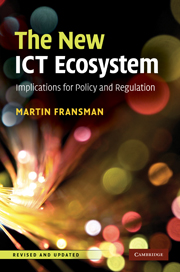Book contents
- Frontmatter
- Contents
- List of exhibits
- Preface
- List of abbreviations and acronyms
- Introduction
- 1 Summary of the argument
- 2 The new ICT ecosystem: architectural structure
- 3 The new ICT ecosystem as an innovation system
- 4 The new ICT ecosystem: a quantitative analysis
- 5 Telecoms regulation
- 6 Policy-making for the new ICT ecosystem
- 7 The way forward: the message to policy-makers and regulators
- Appendixes
- 1 The evolution of the new ICT ecosystem, 1945–2007: how innovation drives the system
- 2 European regulation of electronic communications, 1987–2003
- 3 Some problems with the dominant regulatory paradigm in telecoms (DRPT)
- 4 A short introduction to Schumpeterian evolutionary economics
- 5 Other layer models: OSI and TCP/IP
- 6 Content, applications and services: definitions
- 7 Why do US Internet companies dominate in layer 3?
- 8 How did East Asia (Japan, Korea, Taiwan and China) become so strong in layer 1?
- 9 China's telecoms service providers in layer 2
- 10 Companies in our database, by layer
- Bibliography
- Index
3 - Some problems with the dominant regulatory paradigm in telecoms (DRPT)
Published online by Cambridge University Press: 04 May 2010
- Frontmatter
- Contents
- List of exhibits
- Preface
- List of abbreviations and acronyms
- Introduction
- 1 Summary of the argument
- 2 The new ICT ecosystem: architectural structure
- 3 The new ICT ecosystem as an innovation system
- 4 The new ICT ecosystem: a quantitative analysis
- 5 Telecoms regulation
- 6 Policy-making for the new ICT ecosystem
- 7 The way forward: the message to policy-makers and regulators
- Appendixes
- 1 The evolution of the new ICT ecosystem, 1945–2007: how innovation drives the system
- 2 European regulation of electronic communications, 1987–2003
- 3 Some problems with the dominant regulatory paradigm in telecoms (DRPT)
- 4 A short introduction to Schumpeterian evolutionary economics
- 5 Other layer models: OSI and TCP/IP
- 6 Content, applications and services: definitions
- 7 Why do US Internet companies dominate in layer 3?
- 8 How did East Asia (Japan, Korea, Taiwan and China) become so strong in layer 1?
- 9 China's telecoms service providers in layer 2
- 10 Companies in our database, by layer
- Bibliography
- Index
Summary
This appendix is devoted to a discussion of several papers by academic economists that comment on various aspects of the DRPT.
The optimal access price
The attempt to introduce competition into the previously monopolised telecoms services market from the mid-1980s raised an immediate problem. Potential new competitors would find it difficult to enter the market because factors such as high fixed/sunk costs, economies of scale and scope and network externalities work to the incumbent's advantage, acting as barriers to entry. In order to create sufficient incentives for new competitors to enter regulators would have to allow them to interconnect with the networks of the incumbents.
But this raised a further problem: What price should the incumbent be allowed to charge the new entrants? This was a key question. If the price were too high it would disincentivise entry and therefore limit competition. However, if it were too low it would disincentivise investment by the incumbent, thus threatening the nation's communications infrastructure. (Furthermore, if the price were too low it would also disincentivise the new entrants from investing in their own infrastructure – thus engaging in infrastructure-based competition with the incumbent – perpetuating dependence by the new entrants on the incumbent's infrastructure. This is an important limitation because many believe that infrastructure-based competition is the most effective kind of competition in the telecoms services market.)
In order to solve the problem regulators turned to economic theory in an attempt to calculate the optimal price.
- Type
- Chapter
- Information
- The New ICT EcosystemImplications for Policy and Regulation, pp. 158 - 163Publisher: Cambridge University PressPrint publication year: 2010



